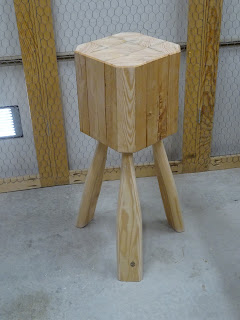The previous post ended with a 12-sided bucket glued up and the top and bottom edges trued up.
 |
| The glued-up bucket |
It still needed a lid. The idea was to have the lid match the bucket with 12 facets. So it was laid out on a 7/8" (or 13/16"?) thick blank. The thought was to have the center at full thickness, tapering to a thin 3/16" at the edges.
 |
| Traced the bucket top rim onto the blank and connected opposing vertices to find a center |
 |
| Sawed and planed the 12 edges. Gauged a 1/8" deep rabbet on the bottom so the lid could be inset into the bucket. The second gauge line on the edges is the 3/16" thickness the lid will taper to. |
 |
| Cut the rabbet with chisels and router plane |
 |
| Got a good fit after a little fettling |
 |
| Really had to think about how to shape the lid. In the end, a saw was used on four facets, then planes finished it off. |
 |
| Four facets sawn and planed. Note the untouched area in the center - that's for a handle later. |
 |
| Side view of above. You can see the extra material that needs to be removed from the two facets adjacent to the center one. |
After that, it was some careful planing of the high spots, aiming to keep all the facet boundaries crisp. It helped to replace the penciled facet boundary lines to ensure planing within the facet. In the end, they weren't as crisp as hoped, but it came out fine.
The lid got a handle, which was a simple piece 7/8" long, starting at 1 1/8" x 1 1/8", then shaped into a 12-sided column, tapering to about 7/8" diameter at bottom. It was attached with a dowel.
 |
| Lid with handle |
 |
| And lid fitted to the bucket |
And that was it. It's finished with several coats of shellac, then a coat of wax and now it will reside in our kitchen to collect food scraps.
 |
| Final placement |
This started out as a prototype, but it came out good enough to be used as the final project. With all those 15° angles on the sides of the individual pieces, it was totally surprising that the bucket came together without having to tweak the angles. This was a good project. It's fun to try something new and challenging. I don't think I'll be getting into coopering full time, though.












































